Notes from the Platform's Edge

1. In recent weeks I’ve gotten a handful of notes from people letting me know that something or other is up with websites they work at or run. “You have probably heard this from everyone, but everyone within Hearst is FREAKING OUT because something happened in FB in last three months where traffic is tanking,” said one. I’ve heard similar things about some, but not all, properties at Conde Nast, which, hmm, just acquired Pitchfork? Congratulations! A number of sites at Gawker Media have fallen off; last week, Gawker.com Editor in Chief John Cook wrote in a memo to employees: “Traffic is flat.” He attributed this, partially, to underperforming writers. At small, less-diversified sites, which were aware and worried about this possibility, and at large, and extremely diversified new media companies, which were aware of and nominally betting on this possibility, the story is similar: referrals from social sites either plateaued or slowed earlier this year, and now they’re falling. Some absolutely, some relative to post volume. On Facebook, a link is worth relatively less than a photo or a video. In theory, it’s also worth less than an Instant Article, but those are still “rolling out” (lol) due to what is apparently a messy and difficult implementation. Regarding Instant Articles, the latest line from Facebook to publishers is “you’ll hear from us first when we’re ready to ramp up.” Regarding traffic woes, some publishers have been told to expect an update this week or “soon.”
2. Anyway, on the Extremely Very Millennial front, a pair of charts. Here is Thought Catalog’s Quantcast chart.
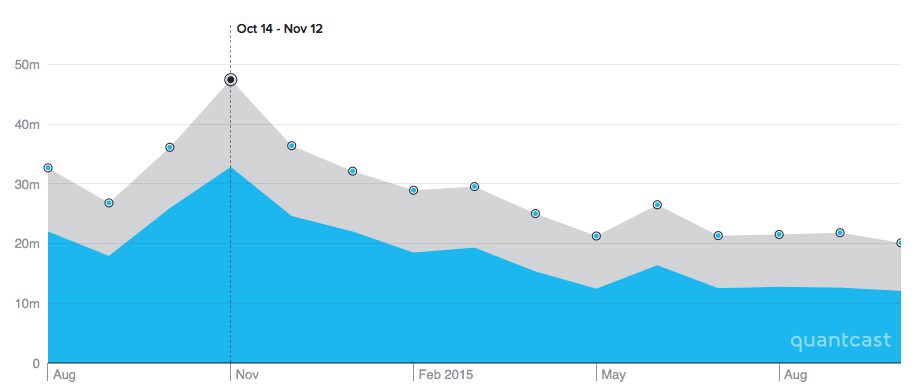
Quantcast grain of salt, etc. But the direction! And here is the chart for Elite Daily:
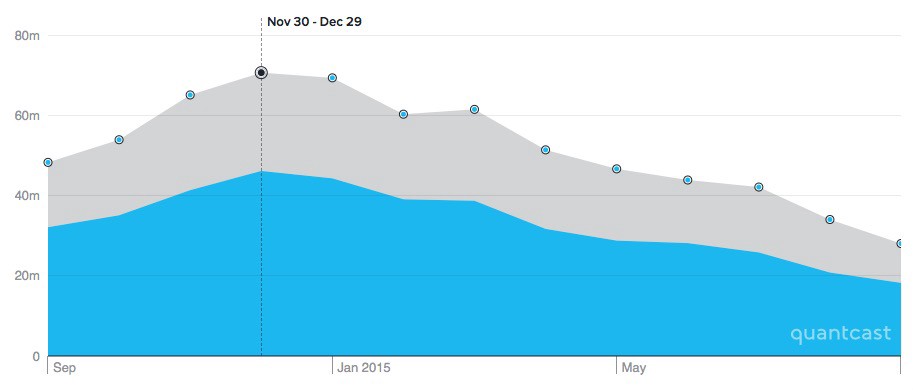
Elite Daily was acquired by The Daily Mail in… [Googles for a few seconds] oh, haha, January.
3. The data that would tell this story most neatly would have to come from Facebook. We could ask how much sharing is happening in general; we could separate out that data into types of media; we could determine not only what proportion of a typical user’s shared posts include links to websites, but how much of their attention is dedicated to links from others. We don’t have that data. But we have slivers. Here are the most-shared publications on Facebook for June, July and August, according to Newswhip:
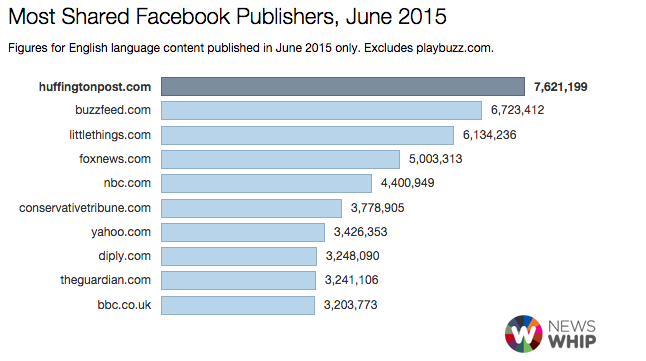
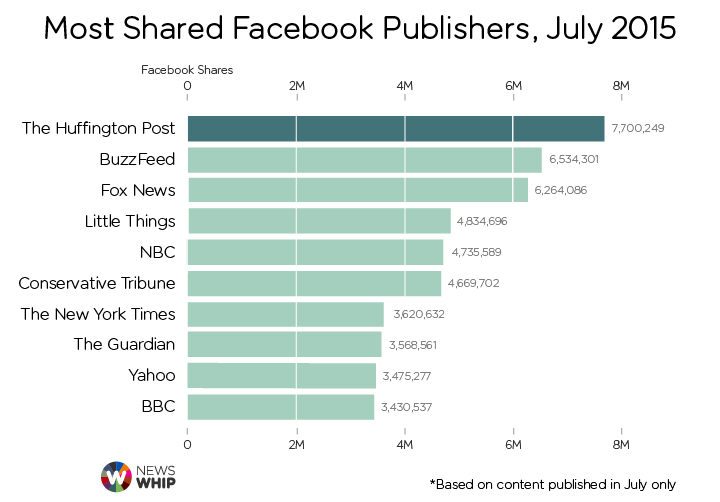
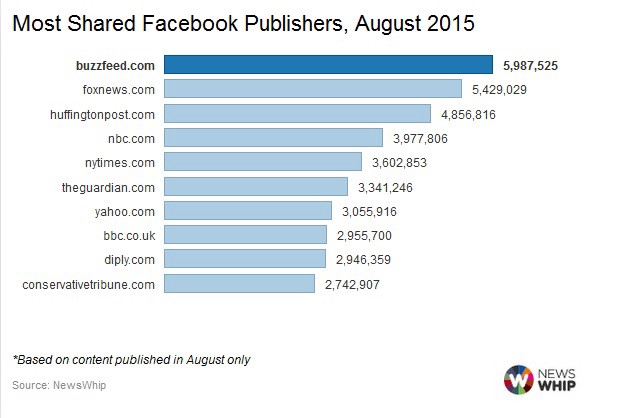
There are a number of stories here aside from the straight rankings. Consider total shares for the Huffington Post each month: 7.6, 7.7, then 4.9 million. Or for BuzzFeed, which is currently on top: 6.7, 6.5 then 5.9 million. Or for Fox News, which seemed to be enjoying an election season bump that has since been mitigated: 5, 6.2, and 5.4 million. Little Things, an extraordinarily deliberate and effective viral web project, disappeared off the chart; PlayBuzz is no longer listed, at their request. But the weirder story is the total shares among the top ten each month. June: 46,781,336 shares between the top ten. July: 48,833,666. August: 38,896,157. This is slightly lower than the most recent trough, in December. It’s worth keeping in mind that, since then, many publishers have heaved resources into Facebook video, which will likely account for a great number of these remaining shares. We’ll have to wait a week or so to see the September numbers. Should be interesting!

4. One week after Twitter launched Moments, which is an attempt to create a deliberate editorial space inside the Twitter app, Snapchat decided to drop the Snap Channel, where it posted original video and text and image content alongside — and in competition with — its various Discover partners. Discover, like Moments, was a completely new space created within a very popular app. Unlike Moments, however, Discover does not draw from, or meaningfully interact with, Snapchat the network — it’s just an extra screen with a list of brands within which you can find editorial content and some ads, which you can screenshot and share if you want. As a standalone app it would not succeed in its current form; as a pulsing icon placed inside one of the world’s most popular apps, who knows. A whole lot of people are looking at it! Publications are still figuring out what to put inside it. Snapchat was trying to figure this out as well, and seemed to have settled on video produced by TV professionals before ceding the space back to its partners and laying those people off. Meanwhile, elsewhere in the app, Snapchat Stories, which are curated from various user posts, continue to make plenty of sense both as something you might watch and as something you might want to pay to inject with an ad. What makes those compelling is less a full engagement with the Snapchat network, such that it exists, than scarcity. There’s no other way to see strangers’ snaps, really! Twitter is public by default and people have been aggregating it to hell for years; Snapchat is by default a much more private service, so Stories feel like something you’re being allowed, not asked, to watch.
5. Twitter’s new editorial space was deliberately created but is being less deliberately filled: Its own staff creates some of the tweet collections while partners create others. Everyone is very clearly still trying to figure out what works: Tweetstorms? Slideshows? Simple aggregations around events? Hashtag games? These experiments follow from the formal restrictions of Moments, which I imagine Twitter will gradually loosen or at least change. Partners are beginning to experiment with content created specifically for Moments, which, if it succeeds, will gradually shape what Moments is in a way that makes it less like the platform it is attached to. If it turns out that more direct aggregations of Tweets — simple best-of style posts — are the Moments that people enjoy most, or live events and video recaps (let’s see how this debate goes!), then Moments will probably focus mostly on that, and track closer to the feeds as they exist already, becoming a place to pick events to temporarily show up in your timeline rather than something that demands to be checked. As Snapchat did, Twitter has left open the question of who will control this new space: Will Twitter just make everything itself? Will it let partners do it on their behalf? Both of these possibilities are left open, now, as are much more severe ones. Are you enjoying Moments yet? Would you look at it if it weren’t sitting in the middle of your app with an unread indicator? Twitter would very much like to know, and can probably already tell.

6. Facebook has so far been more cautious about tacking editorial products onto its platform. Trending Topics, though overseen and written by humans, gives off a distinctly algorithmic smell. Signal, an app to track and search what’s trending beyond the main topics, reaches Facebook users only through reporters. Instant Articles are a functional change to users’ feeds, not their interaction with Facebook as a set of screens and prompts and buttons. With Paper, Facebook released a sort of content-first version of itself: A newsreader that separated news into fairly traditional categories, much like Moments does. The problem was that the most compelling “section” was always the one created from links in your News Feed. The news categories seemed flat in comparison. Even the stories within them felt a little out of place, being as they were tailored by their creators for success within News Feed.
7. Facebook is, however, currently experimenting with a new editorial space. It is testing, with limited partners, an app called Notify, which lets people aggregate… notifications? It was previously reported by Business Insider to be “a standalone mobile news publication.” Now, a source shows us that it looks like this:
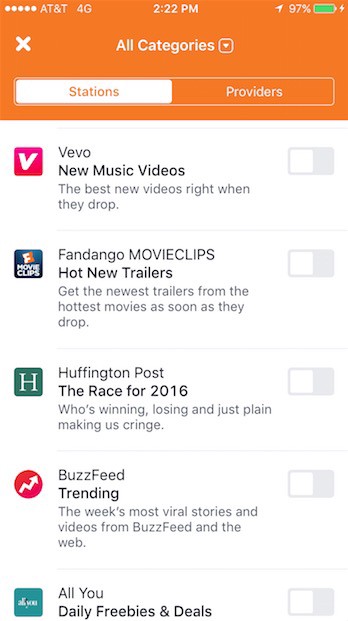
And performs like this:

8. A successful Notify app, or, maybe, a notification pass-through for the Facebook app itself, which would let users select publications or people or, in their language, “stations” and “substations” to follow, would represent the creation of another sort of space: one that was previously inhabited only by Facebook’s own notifications, but which exists within Apple and Google’s notification interfaces. People are conditioned to get notifications from Facebook, which sends billions a day, as well as from news organizations — the Times app’s notifications are considered a hugely important part of the company’s digital operation. Anyway, this app is apparently launching at the end of the month, or somewhere around there? A bunch of publications are testing it out and getting assertive feedback from Facebook about post frequency, type, etc.
9. Apple and Google are both in the middle of big re-thinks about how people are supposed to look at stuff, what apps are for, how they should work, etc: The Apple watch is in one sense basically a notifications machine; both Apple and Google are trying, in newer versions of their OSes, to present bits and pieces of apps’ core functions outside of their respective app interfaces. They are, in other words, inserting new spaces into their platforms, too. (The new Siri has links to news inside it, even! Google Now shows you things it thinks you might like to read, based on things you’ve read.) An Apple Watch future or a Siri future or a notifications-based future would threaten the most obvious ways Facebook and Twitter make money — by cramming ads into feeds — so it makes sense, probably, to at least try to get ahead of it, by becoming a sort of news notification clearinghouse — better or more vital than the notifications sent to users by, say, an Apple or Google News app. So get ready for some buzzing, I guess!
10. Platforms’ early attempts to create editorial spaces are, taken together, at once completely understandable and totally incomprehensible. It’s understandable in that of course a company presiding over a platform of hundreds of millions of people and looking, either deliberately or more desperately, for new places to put ads, would think, hey, let’s bolt a new content and revenue apparatus onto this thing, to capture some of this heat (it’s what all the search and email portals did, too, because why not???). It’s incomprehensible in that, unlike feeds and friend networks, which are intentionally constructed in a way that’s obvious to both a reader and a poster, they don’t have to earn their audiences and therefore don’t know who or what they’re for.
11. What is the sensibility of Twitter Moments? Of Snapchat Discover, or Stories? Of whatever Notify will become? Moments and Discover sit next to their respective networks within the apps, and have generalist editorial staffs either implicitly or explicitly dedicated to vague notions of neutrality; Notify sits next to its network within the operating system, and seems to have no current editorial component beyond exhortations to post consistently (but not too much!). These separations demand new editorial choices from both the user and the platform: who or what to follow or look at, again, or what to shovel into these new empty spaces. Perhaps more important than any editorial “sensibility” is that these space leave behind their platforms’ core ideologies, which are of course all about self-perpetuation. Facebook’s ideology follows from a desire and design for more engagement, always — this is animated and embodied by its network and its feed. Twitter’s does as well, perhaps less effectively. The content that has worked best on both has bent to and exploited this ideology by understanding how it moves in relation to the users’ identities, against which every share or read is contextualized. It is not at all clear where these new editorial spaces belong, exactly, or how they’ll interact with the strange attention economies that led to their creation; it is interesting, certainly, how cautiously they engage with user identity. Though I guess how would they!! Speaking of economies, what’s even the metaphor here. Are these publication-like things tax shelters? Multinationals? Agencies of the state? I guess who cares? We’ll sort that out in retrospect!

12. From the margins of the platform, the transfer of attention from publications to platforms, and the platforms’ sudden desire to do something with this attention — out of a sense of responsibility? opportunity? not need, yet, but a prediction of need? — seems especially perverse. From a more central vantage — say, a company that’s partnering with every platform at once, with broader ambitions to Create All The Content, the concerns are probably more immediate: What do these platforms want from us? What will they then want for themselves? What will be left for the partners? If the platform is asking questions about content, they’re a level closer to the metal: What are we supposed to do with text? What about video? Where do these things go, and what shape should they take? These concerns overlap mostly by coincidence.
13. Publications large and small but especially large spent the last few years in a sort of para-economy, watching their audiences and sometimes revenues explode as the result of informal partnerships with social platforms, which were happy to let these outsiders hustle to adapt all manner of writing and imagery and video to their new contexts. The self-pitying/aggrandizing explanation for the platforms’ annexation of media attention would be that the last few years represent a sort of free-booting period during which media gave Facebook no-strings content in exchange for attention, which was converted into revenue in a system of advertising Facebook was simultaneously intent on destroying.
14. I’m thinking more and more that the various narratives about social media and The News, ours included, have overemphasized the role and responsibility of the media in terms of the content it produces and the role that content purports to play in the world. All along, platforms and publications have been interacting in two ways: on one end, by mingling audience and attention; on the other, by the advertising business model of one replacing the advertising business model of the other. Platforms are where the internet advertising money is going as it leaves the part of the web that supported online publications. Web advertising is getting replaced with something more effective! These new in-house editorial projects located at the center of the platform, rather than at its edges, will succeed or fail based on how they assist in that project — not according to how well they replicate or replace or improve on publications supported by a model they’re in the process of destroying. Publications-like features, or channel-like spaces, just happen to be the only place anyone on either side knows where to start.
